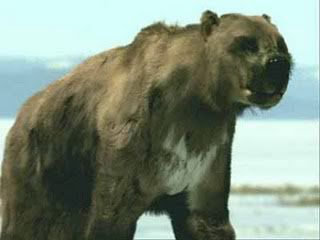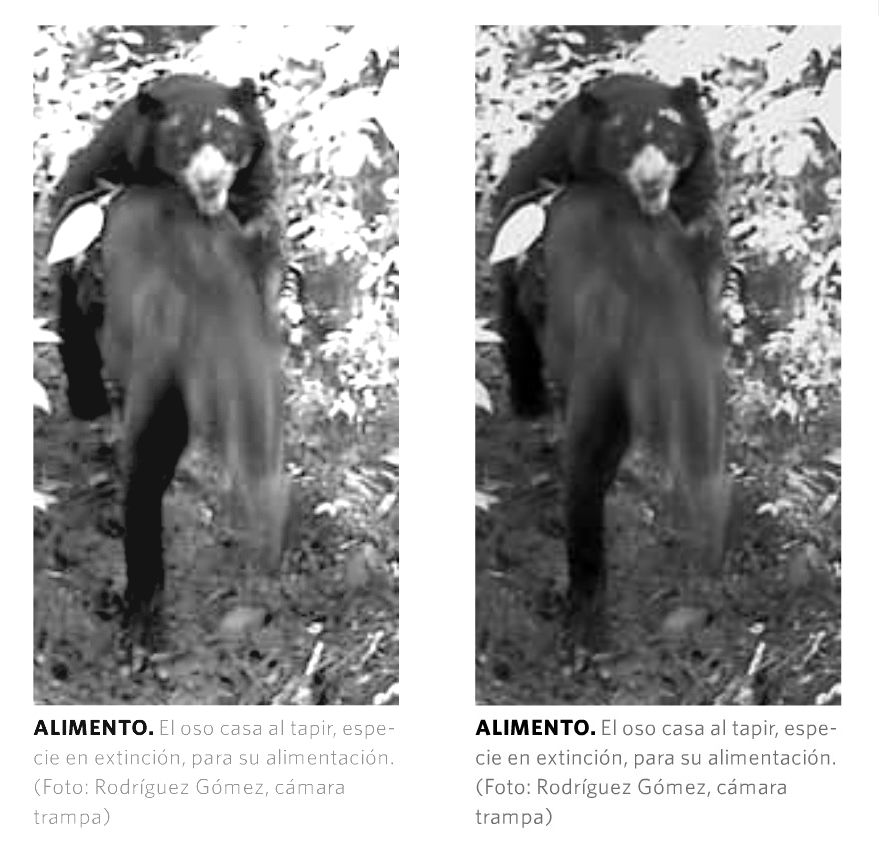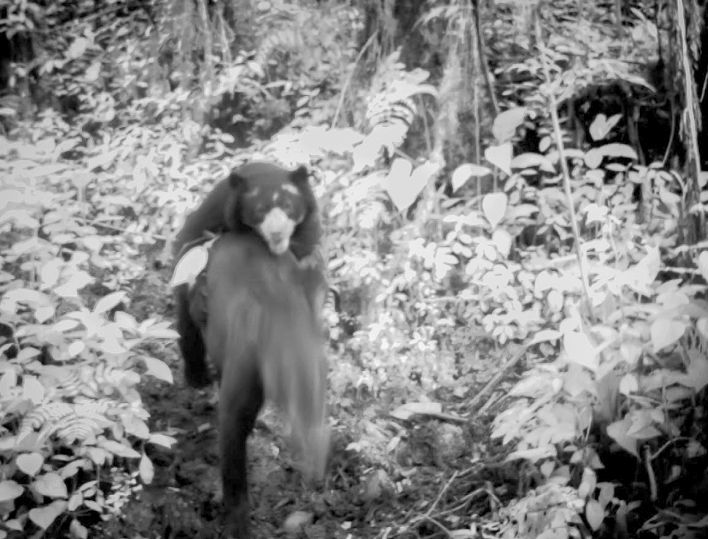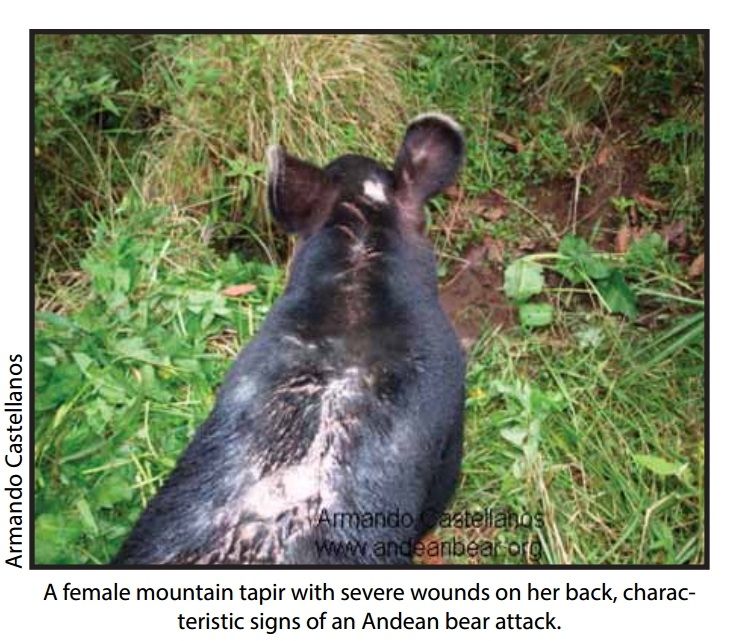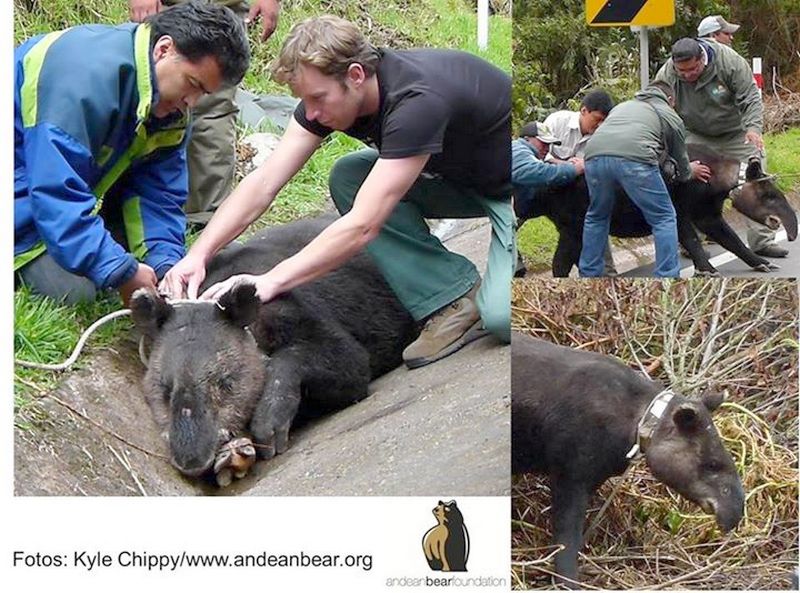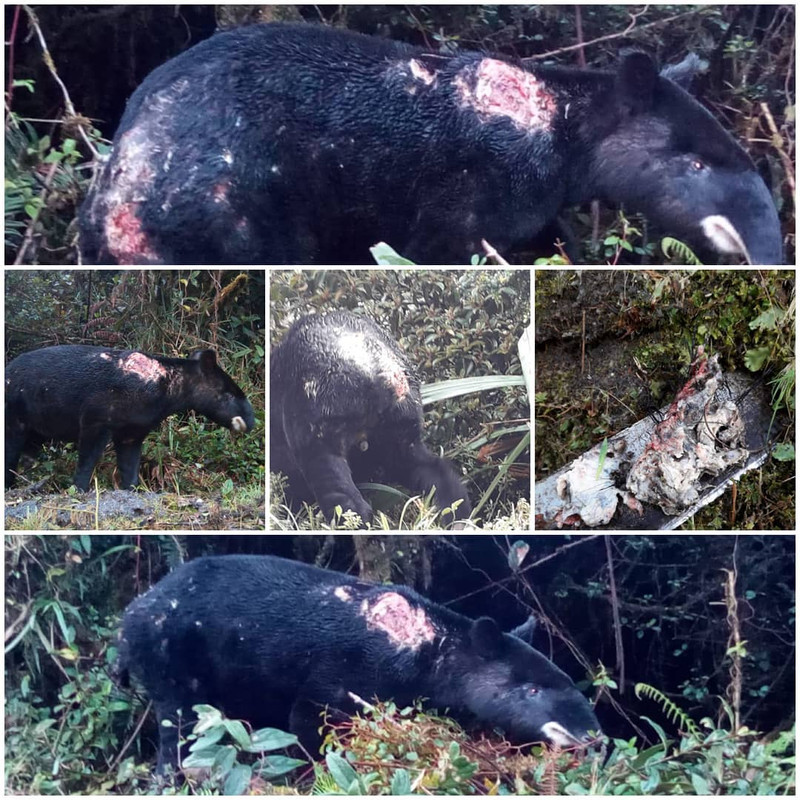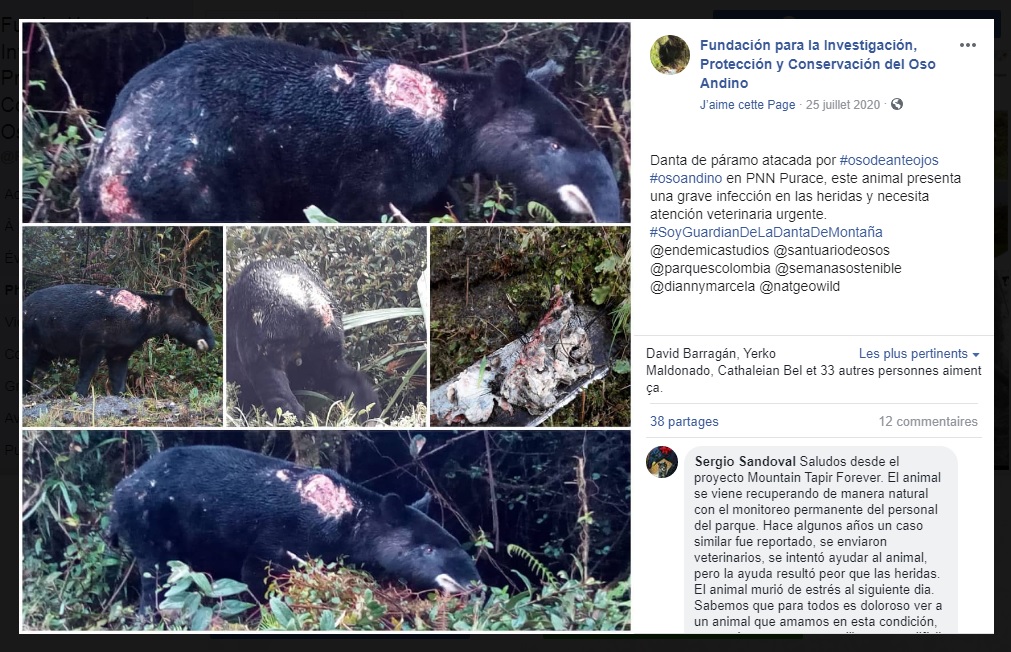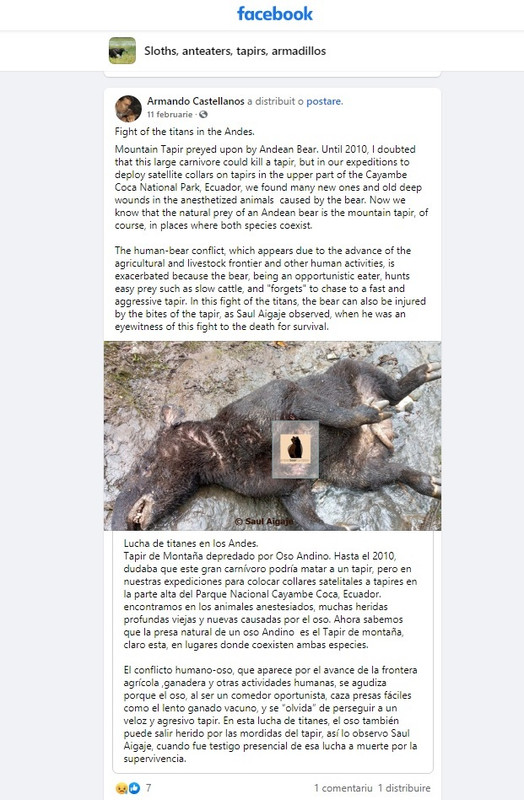Post by sarus on Feb 25, 2012 17:06:56 GMT -9
Study reveals evidences of predatory attacks on mountain tapirs (Tapirus pinchaque) by spectacled bears (Tremarctos ornatus).
- - -
Do Andean Bears Attack Mountain Tapirs?
Armando Castellanos
Member: Andean Bear Expert Team, Human-Bear Conflicts ET, Captive Bear ET,
Tapir Specialist Group, Reintroduction Specialist Group
President, Andean Bear Foundation
c/o 5393 N. Paseo de la Terraza, Tucson AZ 85750, USA
Email: armando@andeanbear.org
Until 1995, biologists and researchers in Ecuador doubted that an Andean bear could prey on cattle. Today we know that they do (Castellanos et al. 2011), and that can also hunt sheep and horses. Later, researchers speculated that the bear could only kill cows because, having been introduced by the Spaniards at the time of the conquest, cattle have not had sufficient time to evolve and adapt to potential predators in the paramo (high altitude grassland) and cloud forests occupied by the Andean bear. The believe was that the native animals like deer (Odocoileus virginianus ustus), rabbits (Sylvilagus brasiliensis) and mountain tapir (Tapirus pinchaque) were fast enough to elude bear attacks, and that when their remains were found in bear excrement, it was because they had been scavenged.
In 2008, biologist Patricio Meza Saltos, while seeking to photograph wild condors (Vultur gryphus) in Hacienda Yanahurco in northeastern Ecuador, captured a sequence in which an Andean bear successfully hunted a rabbit. This photographic evidence supports other former reports from the paramo (Suárez 1985) and led me to think that since the Andean bear could capture something as fast and agile as a rabbit, it could also kill larger wild animals — perhaps even animals as large as the mountain tapir, as reported by Bernie Peyton in the 1980s and by Craig Downer in the 1990s (Peyton 1980; Downer 1996, 1997).
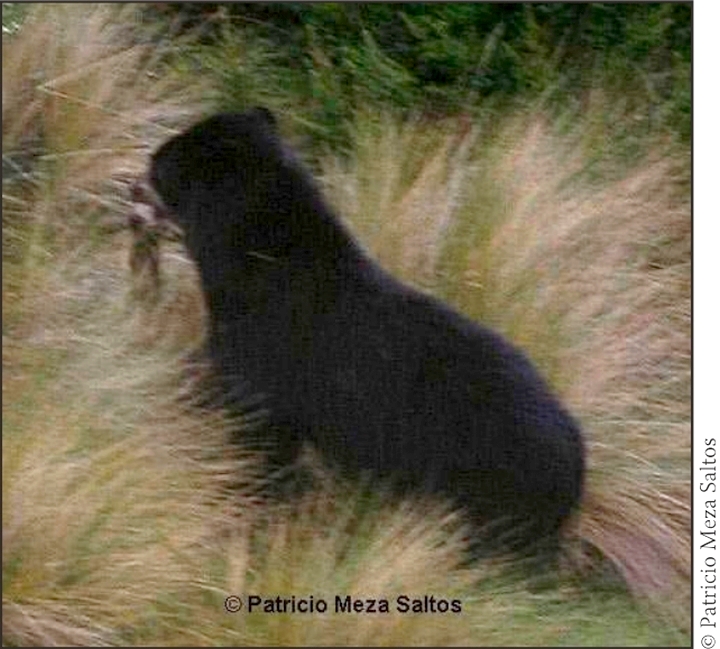
Andean bear catching a rabbit
On August 29 2011, I was on an expedition in the watershed of the Papallacta River in Cayambe Coca National Park(CCNP), Ecuador, to capture mountain tapirs and fit them with satellite collars, to learn more about this endangered species. That day we trapped a male, which after tranquilizing, I deduced was elderly (~20 years old) and about 190 kg (an average size). On one flank there was a large (12cm X 6cm), old wound; around it were deep, healed scratches. According to our veterinarian, Dr. Leonardo Arias, the original wound would have been at least twice that size and had been healing for about two months.
I am convinced that this tapir had been attacked by an Andean bear. The size of the wound and the width and depth of the surrounding scratches suggests they were made by large, broad claws like those of a bear, rather than the finer scratches typical of a puma. The size and form of the scratches is like that found on trees marked by Andean bears (Torres 2011). The wound location, on the flank, is often seen on cows attacked by Andean bears, whereas pumas tend to go for the jugular (when hunting deer, sheep and foals, on which they specialize).
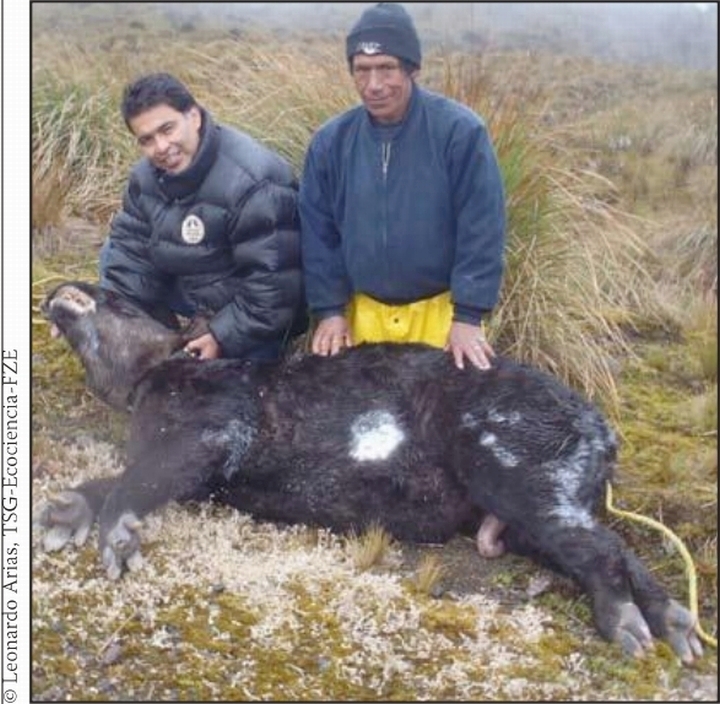
Immobilized mountain tapir with a large, scared-over wound on its flank, likely from an Andean bear attack; the white color is a spray applied to aid healing
At least one other tapir (photographed in the same area in 2008) has been seen with old, deep scratch wounds on its shoulder of a size that suggests they were made by a bear. Additionally, park rangers from the CCNP have observed and reported a bear attack on a tapir several times a few years ago.
There have been numerous reports of bear attacks on cattle in this part of Ecuador for at least the last ten years: Eighty dead cows of 87 reported bear attacks on cattle from November 2009 to June 2011 suggest a high success rate for the bears (Castellanos et al. 2011). A wild male Andean bear may weigh 150–180 kg; a domestic cow in this area perhaps 250 kg and mountain tapirs weigh much the same (males up to 200 kg and females even more). Mountain tapirs, although solidly-built, are cautious in nature, can move fast and have much more stamina than a domestic cow. The individual that I observed obviously got away from the bear. Tapir hair has been previously found in bear excrement (Castellanos 2010), possibly suggesting that some tapirs are not so lucky. The tapir project mentioned above runs for another 12 months and has already installed 50 camera traps in the area. We await the photos with interest.
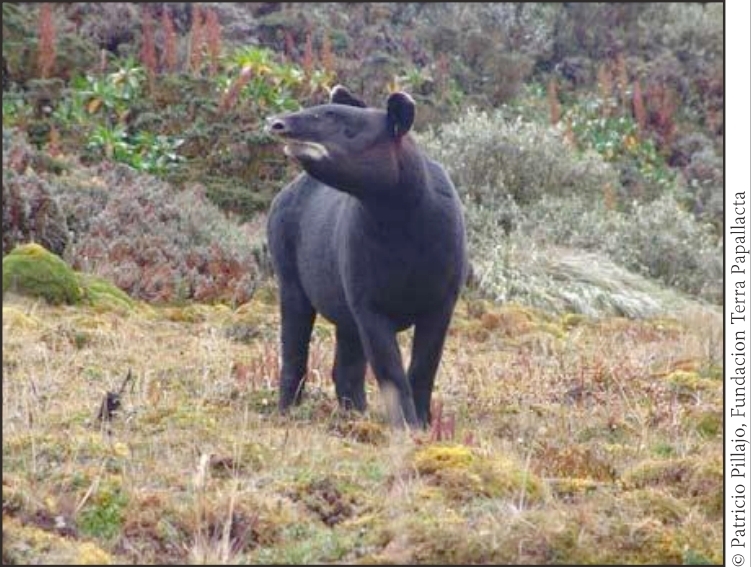
Mountain tapir with old, deep scratches on its left shoulder, likely from an Andean bear
- - -
► www.andeanbear.org/IBN_Nov_2011-bears-tapirs.pdf
► www.andeanbear.org/bear-papers.html
- - -
- - -
Do Andean Bears Attack Mountain Tapirs?
Armando Castellanos
Member: Andean Bear Expert Team, Human-Bear Conflicts ET, Captive Bear ET,
Tapir Specialist Group, Reintroduction Specialist Group
President, Andean Bear Foundation
c/o 5393 N. Paseo de la Terraza, Tucson AZ 85750, USA
Email: armando@andeanbear.org
Until 1995, biologists and researchers in Ecuador doubted that an Andean bear could prey on cattle. Today we know that they do (Castellanos et al. 2011), and that can also hunt sheep and horses. Later, researchers speculated that the bear could only kill cows because, having been introduced by the Spaniards at the time of the conquest, cattle have not had sufficient time to evolve and adapt to potential predators in the paramo (high altitude grassland) and cloud forests occupied by the Andean bear. The believe was that the native animals like deer (Odocoileus virginianus ustus), rabbits (Sylvilagus brasiliensis) and mountain tapir (Tapirus pinchaque) were fast enough to elude bear attacks, and that when their remains were found in bear excrement, it was because they had been scavenged.
In 2008, biologist Patricio Meza Saltos, while seeking to photograph wild condors (Vultur gryphus) in Hacienda Yanahurco in northeastern Ecuador, captured a sequence in which an Andean bear successfully hunted a rabbit. This photographic evidence supports other former reports from the paramo (Suárez 1985) and led me to think that since the Andean bear could capture something as fast and agile as a rabbit, it could also kill larger wild animals — perhaps even animals as large as the mountain tapir, as reported by Bernie Peyton in the 1980s and by Craig Downer in the 1990s (Peyton 1980; Downer 1996, 1997).

Andean bear catching a rabbit
On August 29 2011, I was on an expedition in the watershed of the Papallacta River in Cayambe Coca National Park(CCNP), Ecuador, to capture mountain tapirs and fit them with satellite collars, to learn more about this endangered species. That day we trapped a male, which after tranquilizing, I deduced was elderly (~20 years old) and about 190 kg (an average size). On one flank there was a large (12cm X 6cm), old wound; around it were deep, healed scratches. According to our veterinarian, Dr. Leonardo Arias, the original wound would have been at least twice that size and had been healing for about two months.
I am convinced that this tapir had been attacked by an Andean bear. The size of the wound and the width and depth of the surrounding scratches suggests they were made by large, broad claws like those of a bear, rather than the finer scratches typical of a puma. The size and form of the scratches is like that found on trees marked by Andean bears (Torres 2011). The wound location, on the flank, is often seen on cows attacked by Andean bears, whereas pumas tend to go for the jugular (when hunting deer, sheep and foals, on which they specialize).

Immobilized mountain tapir with a large, scared-over wound on its flank, likely from an Andean bear attack; the white color is a spray applied to aid healing
At least one other tapir (photographed in the same area in 2008) has been seen with old, deep scratch wounds on its shoulder of a size that suggests they were made by a bear. Additionally, park rangers from the CCNP have observed and reported a bear attack on a tapir several times a few years ago.
There have been numerous reports of bear attacks on cattle in this part of Ecuador for at least the last ten years: Eighty dead cows of 87 reported bear attacks on cattle from November 2009 to June 2011 suggest a high success rate for the bears (Castellanos et al. 2011). A wild male Andean bear may weigh 150–180 kg; a domestic cow in this area perhaps 250 kg and mountain tapirs weigh much the same (males up to 200 kg and females even more). Mountain tapirs, although solidly-built, are cautious in nature, can move fast and have much more stamina than a domestic cow. The individual that I observed obviously got away from the bear. Tapir hair has been previously found in bear excrement (Castellanos 2010), possibly suggesting that some tapirs are not so lucky. The tapir project mentioned above runs for another 12 months and has already installed 50 camera traps in the area. We await the photos with interest.

Mountain tapir with old, deep scratches on its left shoulder, likely from an Andean bear
- - -
► www.andeanbear.org/IBN_Nov_2011-bears-tapirs.pdf
► www.andeanbear.org/bear-papers.html
- - -



